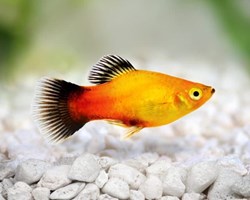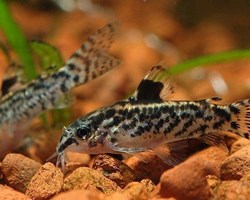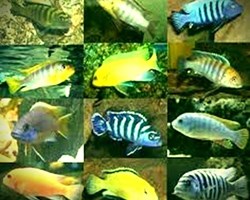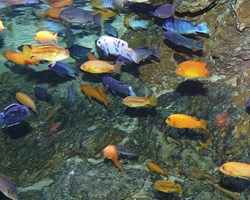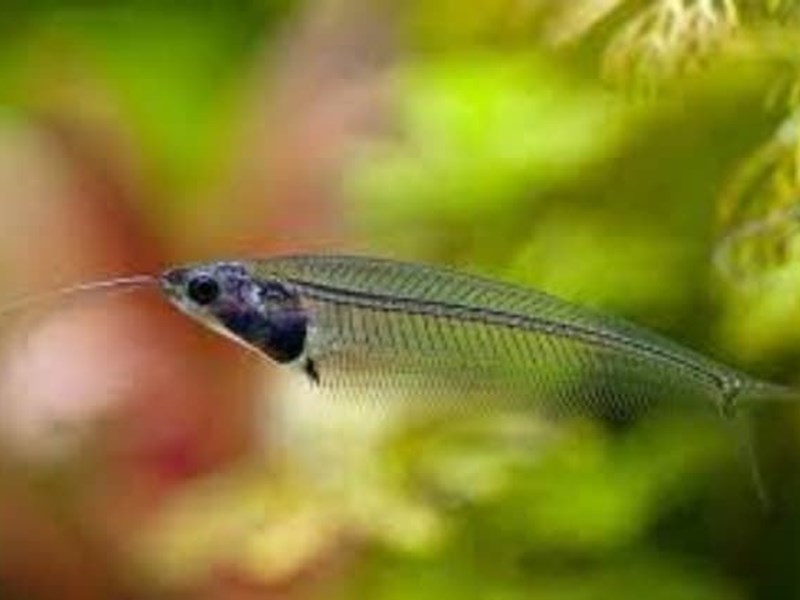
THE CRYSTAL CATFISH OR KRYPTOPTERUS BICIRRHIS:
The glass catfish, family Siluridae, is one of the most suitable fish for the community freshwater aquarium and at the same time the most surprising.
Its body is completely transparent, without coloration on the scales, allowing the bones and thorns to be seen.
It only has a silver coloration on the head.
It has no dorsal fin that is reduced to just a radius.
The anal fin is very elongated, extending from the pectoral fins to the tail.
Its caudal fin is symmetrical.
It has two barbels that serve to locate food.
The arched shape of its body allows it to swim obliquely with its tail down.
It does not present sexual dimorphism and can reach sizes of up to 15 cm, in the aquarium it will not exceed 10 cm.
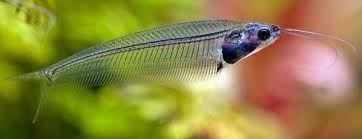
HABITAT AND DISTRIBUTION:
Krytopterus bicirrhis (Cuvier and Valenciennes, 1839) is found in Java, Sumatra, Borneo and to a lesser extent in East India and Thailand.
It inhabits fast currents that are mostly turbid with many particles in suspension with low visibility.
This poor visibility has developed in the glass catfish a greater sensitivity in its lateral line as well as the two commented barbels.
The waters where this species of catfish inhabits are tropical with temperatures around 24º C, neutral pH and moderate hardness.
It can be found in nature in schools in the middle and lower areas of the water column.
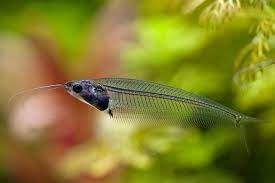
THE GLASS CATFISH IS A FRESHWATER COMMUNITY AQUARIUM FISH:
The K. Bicirrhis is a peaceful and somewhat shy species which makes it a perfect candidate for a community freshwater aquarium populated by calm species.
At Glu Glu Pet we recommend that you do not mix it with barbels that will tend to nibble their barbels and it is also not recommended to mix it with other species such as Cichlids with a territorial character or very nervous species such as zebra danios and other species of fast-swimming cyprinodontids.
Taking care of their barbels is a fundamental aspect of their maintenance because if they lose them, they can stop eating.
It is important to keep this in mind when handling it with brackish so that it does not get hooked on them and can be damaged.
Never keep individually, always do it in groups of at least 4 individuals.
If he is alone, his shyness will prevent him from eating and he can be a target of diseases.
It is a species that we can see permanently suspended in a group in the middle of the aquarium.
Swimming will be slightly inclined as we have mentioned with the tail down.
His movements are slow.
We must offer space to swim in the aquarium although it is convenient that it is well planted.
It is advisable to mitigate the brightness of the lighting with floating groundcover plants and place a dark substrate to avoid light reflection.
If we have very powerful lighting, it is common for it to seek refuge under the leaves.
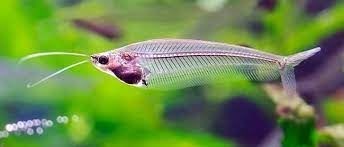
THE NUTRITION OF CRYSTAL CATFISH:
When we turn off the lighting, it will be the moment of greatest activity of the glass catfish, it is the moment for the search for food through the use of their barbels.
It is an omnivorous species that adapts well to frozen and freeze-dried foods, mainly mosquito larvae and brine shrimp.
It may even accept flake food.
The movement of water in the aquarium plays a fundamental role in their feeding.
This must allow the food to remain for a time in the water column so that it can be reached by the fish.
This transparent fish is not as voracious as other catfish species but will prey on guppy or platty fry. Thanks to its transparent body it is easy to see if it is well fed because it will be easy to detect if its stomach is more swollen after eating.
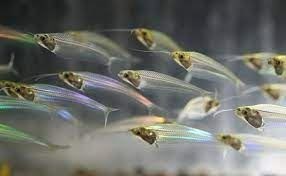
NEEDS OF THE GLASS CATFISH AND ITS MAINTENANCE OF THE AQUARIUM:
The K. Bicirrihis is a simple species to keep without complicated requirements.
It tolerates a wide range of temperatures, between 23 and 28º.
Values between 24-25º are preferable.
Ph neutral and a hardness not exceeding 10º Gh.
If the acidity of the water is very pronounced, the glass catfish will be fatigued and may gasp.
It is time not to be late in changing the water.
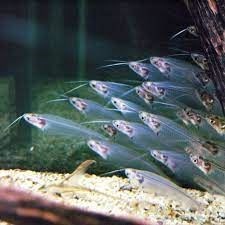
THE REPRODUCTION OF THE GLASS CATFISH:
Its reproduction is quite unknown with few cases of reproduction in captivity.
This little information for breeding is based on the difficulty that exists in determining the sexual maturity of the fish and their sex.
It is known that she lays transparent eggs on the leaves of plants.
It is not a very swimming fish species.
To maintain the group of individuals in Glu Glu Pet we recommend that you have an aquarium from 60 liters.
Newly arrived fish will take a few days to adjust to their new home and may take a few days to start eating.
Therefore, we will not keep them with fast-moving fish that can stress it.
It is common that the stress after its introduction to the aquarium pushes it to swim quickly and without control, being able to collide with the glass.
A situation of over stress can push the animal to bury itself and even jump out of the water.
It is a good recommendation to acclimate newly arrived animals with the light off.
Once acclimatized, it is a long-lived fish that can live up to 8 years.
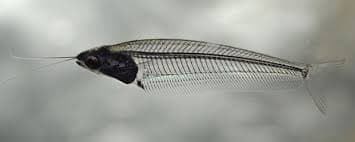
Other articles that may interest you:

